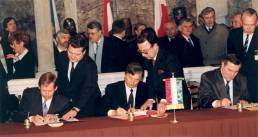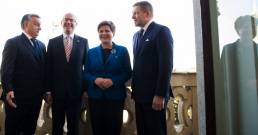If asked who are the “bad boys” of the European Union, our first thoughts will probably turn to Hungary and Poland. However, if we look at the two in a slightly larger context, we realise that their cooperation has often taken place within the Visegrád alliance, thus involving two other EU member states: Czechia and Slovakia. One should not jump to the conclusion that the whole grouping represents a band of rebelling countries whose only goal is to constantly block and oppose EU decisions. Nevertheless, this conclusion is often drawn – especially by Western Europe.
Some regional groupings within the EU are not very well known, yet such cooperations, e.g. the Bucharest Nine, the Weimar Triangle or the Slavkov Triangle, still play an important role today. The Visegrád Group (V4) is one of the oldest regional groupings and, at least since the migration crisis of 2015, probably the most famous. If we examine their pre-2015 history, however, and more especially the latest developments, we would suggest that the V4 has shown important divergences in its relations to the EU over the years: moving from a clearly pro-European position into the role of a blocking minority. The most recent events though have fundamentally reshaped their dynamics.
What is the V4 alliance and why is it called Visegrád?
The Visegrád 4 was founded on 15 February 1991 in the Hungarian city of Visegrád, an allusion to the 1335 Visegrád Congress. Initially called the V3, it contained Hungary, Poland and Czechoslovakia. The newly established Central European alliance, recently freed from Soviet socialism, had several important objectives including to fully restore sovereignty, democratic order and freedom and to eliminate all kinds of manifestation of totalitarianism and autocracy. Concretely this meant that all three countries (and later four, after the peaceful split of Czechoslovakia) were determined to become full members of both NATO and the EU in the long term. This narrative can be characterised as a wish to return to Europe and to the West: the V4 strongly emphasised that they belonged to the other European countries and that Europe would be reunified once again.
„The V4 strongly emphasise that they belong to the other European countries and that Europe shall be reunified again.“
The democratic transition was not without difficulties, especially in economic terms. Therefore, on the 21st of December 1992, the Central European Free Trade Agreement (CEFTA) was signed by the V3 to support regional trade and the transition to a market economy. In 2000, the sole institution of the V4 was founded, the International Visegrád Fund (IVF) with its secretariat in Bratislava. Initially, the IVF’s goal was to support cultural and scientific projects, research, education and youth relations within the V4, but projects were soon established beyond the V4’s borders with the clear goal to involve other Central and Eastern European partners as well.

EU accession achieved… what next?
The final goal of the V4-alliance, i.e. the EU-accession, was achieved on the 1st of May 2004. After this huge success, the V4 had to redefine its framework and it thus became a platform for regional cooperation to strengthen “the identity of the Central European region” and to contribute “to the fulfilment of the European Union’s common goals and objectives”. An important project for the V4 was to help aspiring countries to join the EU and to support the EU’s neighbourhood policy – the V4 actually considered itself as a pioneer for joining the EU.
„The V4 considered itself as a pioneer for joining the EU and wanted to help aspiring countries to join“
From 2004, the V4 in fact became a forum where V4-members could meet and discuss EU-decisions to coordinate their regional interests within the original framework. As the IVF is the only institution, V4-cooperation manifests itself in regular summits between the presidents and prime ministers of the members, or between the respective ministers on a specific issue. The V4 soon became particularly active in the area of foreign policy: for example they highly prioritised the Common Security and Defence Policy and the EU’s neighbourhood policy; within its framework they also played an important role in launching the Eastern Partnership program in 2009 under the Czech EU Council presidency.
2008 marked the start of a new period within the V4 as the members could effectively represent their positions and priorities through their EU Council presidency. National interests became more important, yet the regional Visegrád cooperation was not lost. The V4 as a forum was ideal for discussing common regional goals that could be re-discussed and implemented on an EU level thanks to the Council presidency.
The turning point: 2015
The migration crisis of 2015 can be considered as a turning point in V4-EU relations. Protests and rebellion became common features for all four countries as a response to EU migration management. At this time, the V4-countries’ identity clearly moved away from the ‘Return to Europe’ narrative. A paradigm shift took place where they emphasised sovereignty from ‘Brussels’, Central European leadership and an attitude of ‘othering’ (meaning that „we distinguish ourselves from ‘Brussels’ that wants to impose its rules on us“). The V4 became a brand name for the blocking minority in the EU, mostly in a negative context.
„The V4 became a brand name for the blocking minority in the EU, mostly put in a negative context.“
In summer 2015, under the Czech V4 presidency, the V4 states had the opportunity to discuss their positions and interests and all of them rejected the mandatory relocation system. Their main argument was that the EU agenda did not seek answers to the problems of the transit countries in the Western Balkans or in the migrants’ countries of origin. Also, they clearly opposed the obligation to take in migrants: all V4 member states declared their belief in homogenous societies (which was already the situation in all four states, with the exception of some minority-groups within the countries, e.g. Roma) and did not wish to welcome foreign cultures.
The common rejection of the quota system created significant solidarity among the V4 states. Most importantly, they managed to stand up against the EU and against migration as a unified entity and as a regional alliance, mainly thanks to the Visegrád Group which gave them a platform where they could develop their strategy.
„The migration crisis created an excellent opportunity especially for Hungary and Poland to set up an international anti-EU position through the Visegrád Group.“
In 2016, however, Slovakia started to play a mediator-role, especially under their EU Council presidency, and during the V4 summit in Bratislava in September 2016 the V4 states agreed on a strategy called ‘flexible solidarity’. This enabled EU members to take a voluntary number of migrants, ruling out any impositions whatsoever. Unlike Poland and Hungary, the Czech Republic and Slovakia started to represent a somewhat more moderate view, due to the demographic opportunities offered by immigration.

It is important to note that the migration crisis created an excellent opportunity, especially for Hungary and Poland (already strongly criticised in the EU for their stance on the rule of law), to set up an international anti-EU position through the Visegrád Group, and a regional counterbalance to mainstream political discourse in the EU. The main motivation came, on the one hand, from domestic politics – especially the fact that the Polish and Hungarian governments could use the migration crisis to significantly benefit their own standing at national level – and on the other hand, from the chance to advertise the Visegrád-project as an alternative pan-European issue.
„The V4 built up a narrative that they were leading a struggle for freedom against the EU and did not obey to the imposed rules“
In this way, the V4 states were successfully able to spread their vision of another Europe, based on traditional, conservative, Christian values, and their message that the EU as a project was about to fail due to harmful liberalism. The V4 also managed to build up a narrative that they were leading a struggle for freedom against the EU and did not obey to the imposed rules – this populist discourse succeeded in going beyond V4 borders and reached other populist or far-right nationalist, anti-EU parties, thus boosting pan-European, right-wing populist cooperation.
And after the migration crisis?
No crisis lasts forever. At the end of the 2010s, the migration crisis also started to lose its momentum – and a new crisis emerged. The connection to Russia and the Ukrainian conflict is of particular importance in this context: since 2014, there has been a war in Europe close to the Visegrád Group’s borders, to which both the EU and the V4 had to react. In order to do so the V4 founded the V4-EU battlegroup led by Poland, which stationed NATO troops on V4 territory.
As for EU sanctions, in force since 2014, the V4 states, whilst not actually vetoing them, have expressed their positions in different ways. Poland has pushed for even more sanctions and also strongly opposed the German Nord Stream 2 project. Hungary and Slovakia, by contrast, declared that “sanctions [were like] shooting ourselves in the foot” and that the EU and Hungary will suffer more from these sanctions than Russia; and Slovakia said it would even veto them if the sanctions endangered Slovak economic interests. Eventually, the V4 could not agree on a common foreign policy position concerning Russia, although they have all supported Ukraine since November 2013.
„The dynamics within the V4 regarding Russia have started to change, with Poland, Slovakia and the Czech Republic actively supporting a pro-European stance on Russia, while Hungary is pursuing ‘swing-politics’.“
The turning point within the V4 arrived in April 2021, when it became clear that Russian secret agents had exploded two Czech ammunition depots in 2014, in which two civilians also died. The V4 as an alliance tried to agree on a joint statement condemning Russia, but the final form was a lot shorter and weaker than initially planned. In the statement, only Hungary was against including V4-support for the Belorussian democratic movement, for the Ukraine, and for the condemnation of the Nord Stream 2 project.
Hungary was also the only country that did not expel Russian diplomats. Following governmental changes in the Czech Republic and Slovakia (with Petr Fiala and Eduard Heger as their respective prime ministers), the dynamics within the V4 regarding Russia have started to change. Poland, Slovakia and the Czech Republic are actively supporting a pro-European stance on Russia, while Hungary is pursuing ‘swing-politics’, promoting Russian relations but not hindering common EU sanctions.

The start of a real clash among the V4
As regards the latest EU-sanctions, even Hungary has been cooperating on all issues (after initially holding up the discussions however). The EU was able to start unified measures against Russia relatively soon after Russia’s invasion. Yet, Hungary once again emphasised that it could not support the EU’s independence from the Russian energy sector, as it would endanger low heating costs for Hungarian households.
„I am very sorry that Hungarian politicians now find cheap Russian oil more important than Ukrainian blood.”
With V4 cohesion seemingly even more shattered than before, we are at another turning point: both the Czech and the Polish defence ministers refused to participate at a V4 meeting in Budapest in March 2022. Orbán has been strongly criticised, not only by EU politicians, but also by V4 leaders and ministers: for example, Jana Černochová, the Czech Defence Minister tweeted at that time: “I have always supported the V4, and I am very sorry that Hungarian politicians now find cheap Russian oil more important than Ukrainian blood.”
Even though some kind of clash has been in process since 2018 (with Hungary and Poland facing criticism on the rule of law resulting in a 2+2 split within the V4), the current situation is much more severe. In the light of the Russian-Ukrainian conflict, another split in the V4 is not inconceivable, resulting in a 3+1 grouping (Hungary against the rest). As the deputy foreign minister in Poland, Marcin Przydacz claimed, these Russia-related tensions have existed between Hungary and Poland since 2014 and it was the main reason why the V4 avoided any kind of joint statement on military topics concerning Russia. However, since Russia has attacked the whole of Ukraine, this is no longer possible and Polish critics of Hungary have become harsher: Kaczyński himself declared that if Orbán was not willing to condemn Russia for the mass killings in Bucha, “we cannot cooperate as we had in the past if this continues. My assessment is unequivocally negative — I must admit that it is all very sad. When Orbán says that he cannot see what happened in Bucha, he must be advised to see an eye doctor.”
Is this the end?
The tensions within the V4 are also apparent from the fact that the V4 prime ministers did not hold a coordinating meeting before the Czech Republic took over the EU Council presidency in July 2022 – which might signal that currently no member is interested in deeper regional cooperation. This is also supported by Polish efforts to bring aboutcloser ties within the Three Seas Initiative and the Bucharest Nine grouping to promote NATO interests and thereby push V4-topics into the background.
Groupings such as the Slavkov Triangle, with Austria, the Czech Republic and Slovakia, might also gain greater importance. Paweł Musiałek, a Polish researcher at the Jagiellonian University, even claimed that he did not consider the hypothesis completely unlikely that the V4 will transform into the V3, with the exclusion of Hungary. He writes that Polish-Hungarian relations have never been this bad since the Russian invasion, whereas Poland has never been so close to Slovakia and the Czech Republic. In view of the forthcoming Polish parliamentary elections in 2023, in which the PiS-party may be ousted and an opposition party could re-establish a government that is committed to Europe, it will be even more likely that the V4 in its current form will lose its importance and Hungary could be left isolated.
„In the longer term, this could lead to the construction of a new populist bloc with EU candidate countries.“
Hungary might have to look for new partners and a different regional cooperation, for example among the Western Balkan countries, some of whom are already receiving Hungarian investments. In the longer term, this could lead to the construction of a new populist bloc with EU candidate countries. Serbia, currently closest to achieving EU membership status, has a newly re-elected president who opposes sanctions against Russia. Aleksandar Vučić is even seeking closer ties in order to secure gas deals.
It is also important to note that the Western Balkans might soon get tired of having to wait for years, or in some cases even decades, for their EU accession application to go through. If they get the feeling that the EU is not interested in their inclusion, it is likely that they will open their economies to other trading partners, especially Chinese and Russian investors. This tendency may intensify if Hungary establishes a closer regional alliance with the Western Balkans, reinforcing relations with Eastern partners.
What should the EU do?
First of all, the EU should understand that the Western Balkan’s EU-accession is also in their interest. The fast reaction given to Ukraine should also be given to the Western Balkan countries, especially those who have been waiting for more than 15 years, such as North Macedonia (since 2005). Another key priority for the Union should be to support Hungary’s relations with the Western Balkan countries, but only in democratic, pro-European terms, avoiding the establishment of a new populist bloc. Concretely, this could mean, for example, EU-financed economic regional investments to offer an alternative to the Chinese Belt and Road Initiative, but strictly subject to anti-corruption conditions.
Secondly, the EU should seek to impose more effective rule of law mechanisms, unified sanctions against Hungary by all the other member states, strict conditions for NGEU-funds and enhanced control over any kind of EU-loans flowing into Hungary. The Orbán-government and its network is partially financed by EU-funds, so an effective step could be for the EU to exercise harsher control over these payments.
„V4 is definitely not dead, but it is taking a break due to Hungary’s position on the war”
Whether the V4 will be revived is uncertain, at least in the coming months or even years. It will largely depend on Poland’s stance and on the Polish elections, as well as on Hungary’s Russia-politics. If the 3+1 splitting is maintained, the alliance will lose its efficiency and most likely also its viability. As Mikuláš Bek, the Czech Minister for European Affairs stated, “the group is definitely not dead, but it is taking a break due to Hungary’s position on the war”. Nevertheless, at least the V4 institutions are still working; the Slovak V4 presidency announced in June that it will prioritize building a strong Central Europe in the EU based on regional initiatives, especially regarding current issues such as energy security, defence and climate change. However, a functioning V4 needs to operate in a cooperative manner, characteristic of the alliance up until the end of the migration crisis. They can only be effective if all four members represent similar national interests and values whilst avoiding an ideological interpretation of the ‘V4 brand’.

Copyright Header Picture: shutterstock/Dana S.; Copyright Founding Picture of the Visegrád 4: Wikimedia/Péter Antall; Copyright Visegrád 4 in 2015 in Prague: Wikimedia/P. Tracz/ KPRM; Copyright the V4 on a map: shutterstock/Amokk; Copyright Picture of the Author: Anna Lelkes
Könnte Sie auch interessieren
9. Juli 2024
Konstantin von Notz : „Es ist Zeit, unsere Demokratien sehr entschlossen aufzustellen“
Er steht seit diesem Jahr an der Spitze des Geheimdienstausschusses des…
1. Juli 2024
European Parliamentary Elections: A Debacle for Pro-EU Parties or Their Last Chance?
Between 6 and 9 June, 400 million Europeans voted in the European Parliamentary…
24. Juni 2024
Dissolution of Parliament: Good or Bad for Democracy?
An hour after the results of the European elections, Emmanuel Macron announced…


